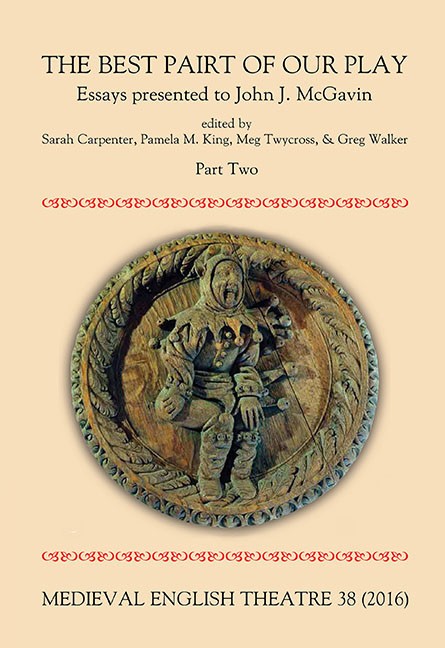 Medieval English Theatre 38
Medieval English Theatre 38 Book contents
- Frontmatter
- Contents
- Editorial
- The Funeral of Walter Scott, First Earl of Buccleuch: A Grand Ceremonial Occasion
- The Bright Star of the North: James I and his English Coronation
- ‘Ye know eek that in forme of speche is change’: Chaucer, Henryson, and the Welsh Troelus a Chresyd
- Playing the Crucifixion in Medieval Wales
- ‘My Boy shall Knowe Himself from Other Men’: Active Spectating, Annunciation, and the St John's College Narcissus
- ‘I Speke so Miche to Ȝow’: Authority, Didacticism, and Audience Address in Middle English Sermons and Morality Plays
- Early English Spectatorship and the ‘Cognitive Turn’
- The Theatre of the Mind in Late-Medieval England
- Poetics and Beyond: Noisy Bodies and Aural Variations in Medieval English Outdoor Performance
- Women and the Performance of Libel in Early-Modern
- Abraham Sacrifiant
- Miscellaneous Endmatter
The Bright Star of the North: James I and his English Coronation
Published online by Cambridge University Press: 20 April 2017
- Frontmatter
- Contents
- Editorial
- The Funeral of Walter Scott, First Earl of Buccleuch: A Grand Ceremonial Occasion
- The Bright Star of the North: James I and his English Coronation
- ‘Ye know eek that in forme of speche is change’: Chaucer, Henryson, and the Welsh Troelus a Chresyd
- Playing the Crucifixion in Medieval Wales
- ‘My Boy shall Knowe Himself from Other Men’: Active Spectating, Annunciation, and the St John's College Narcissus
- ‘I Speke so Miche to Ȝow’: Authority, Didacticism, and Audience Address in Middle English Sermons and Morality Plays
- Early English Spectatorship and the ‘Cognitive Turn’
- The Theatre of the Mind in Late-Medieval England
- Poetics and Beyond: Noisy Bodies and Aural Variations in Medieval English Outdoor Performance
- Women and the Performance of Libel in Early-Modern
- Abraham Sacrifiant
- Miscellaneous Endmatter
Summary
The survival of the ancient English coronation ceremony is surprising. The establishment of monarchical supremacy following England's break with Rome, together with religious reformers’ critical scrutiny of ceremony throughout the sixteenth century, could have threatened the Latin ritual, rooted in Anglo-Saxon notions of the election of a king and his transformation into a sacred person with priestly powers — a persona mixta. But the coronations of all the Tudor monarchs, from Henry VII to Elizabeth, remained largely unchanged. And, in 1603, when James VI of Scotland was crowned James I of England, following ceremonial precedent was a way of emphasizing James's legitimacy (despite being a Scot) and claiming continuity with the past. Many of the verses and speeches written in celebration of James I's accession depict him as a new star — a natural successor — while also alluding to the powers of the oil with which his body would be anointed in the coronation ceremony, following the precedent of English kings. The Recorder of London Richard Martin's welcoming ‘Oration’ to James, for example, describes him as the ‘bright starre of the North’ while Henry Petowe in England's Caesar refers to him as God's ‘anoynted derest loue’. Shakespeare probably wrote his sonnet 107, ‘Not mine own fears …’, in the year of James's accession, and it certainly alludes to both Elizabeth and James:
The mortal moon hath her eclipse endur'd And the sad augurs mock their own presage; Incertainties now crown themselves assur'd And peace proclaims olives of endless age. Now with the drops of this most balmy time My love looks fresh, and Death to me subscribes …
The ‘mortal moon’ (Elizabeth) has been eclipsed, and the coronation and anointing of a new king are invoked by ‘incertainties’ being crowned and the ‘drops of this most balmy time’. Monarchical succession here is both a natural event (albeit portentous) — a moon is eclipsed and another body takes its place — and an event that is inextricably linked to crowns and oil.
- Type
- Chapter
- Information
- Medieval English Theatre 38The Best Pairt of our Play. Essays presented to John J. McGavin. Part II, pp. 22 - 37Publisher: Boydell & BrewerPrint publication year: 2017


